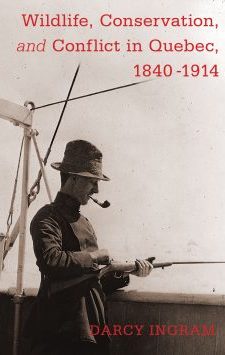Who invented our conservation movement: Hippies? First Nations. Settlers? The answer is none of the above. Conservation was created by 19th century corporations and wealthy urban sportsmen. The first national park in Banff was intended as a resort for the rich. Critics cursed it.
“There is no reason for the government to go into the business of entertaining,” Liberal MP John Kirk of Nova Scotia told the House in 1887. “This is a benefit to the wealthy while the poor people are compelled to foot the bill.”
If the motives of corporations like Banff’s Canadian Pacific Railway resort builders were selfish and narrow, the result was good and beyond debate. There is a park. Wildlife and waterways were preserved.
Wildlife, Conservation and Conflict in Quebec 1840-1914 is the first book we know of that tells the odd story of the birth of ecology in Canada. In anecdote and fascinating detail, author Darcy Ingram confirms conservation was created by millionaires eager to ape the habits of Old Country gentry, “the twinned ideas of ‘improvement’ and ‘patrician culture,’” writes Ingram.
In 1858 the first organization of its kind was created, the Fish & Game Protection Club of Lower Canada. Excluded from membership were Indigenous people and homesteaders who were reduced to prosecution for poaching or paid work as guides. “Conservation amounted to a process of dispossession that saw commercial and subsistence hunters and fishers pushed off the province’s better hunting and fishing territories, stripped of former claims to fish and game resources and left to cope with seasonal and other restrictions,” writes Ingram.
Nor were clubs intended to raise hell with industry. Ingram notes there is no instance in which any timber leases were upset for fear of harming the fish, mainly since club members were timber barons. “It was the tremendous wealth generated by the timber industry that led these men to mimic the cultural and material practices of landed society, including the desire to devote their wealth and their leisure time to elite sporting activities such as salmon angling,” writes Ingram.
The elitism was beyond dispute. Prime Minister John Abbott, a Montreal railway attorney who led the country in 1891, owned his own salmon stream. When Quebec auctioned river leases to the very wealthy, buyers at one club included Governor General Lord Dufferin, Finance Minister Alexander Galt, the chair of the Senate banking committee and George Stephen, president of the CPR. In one three-week binge on the Matapedia River in June 1877 Stephen and his guests landed 2,800 pounds of salmon. They donated most of the catch to local villagers.
If their enjoyment was purely private, their legacy is profound: a nation of pristine lakes, streams and forests.
By Tom Korski
Wildlife, Conservation and Conflict in Quebec 1840-1914 by Darcy Ingram; UBC Press; 304 pages; ISBN 9780-7748-21414; $34.95






